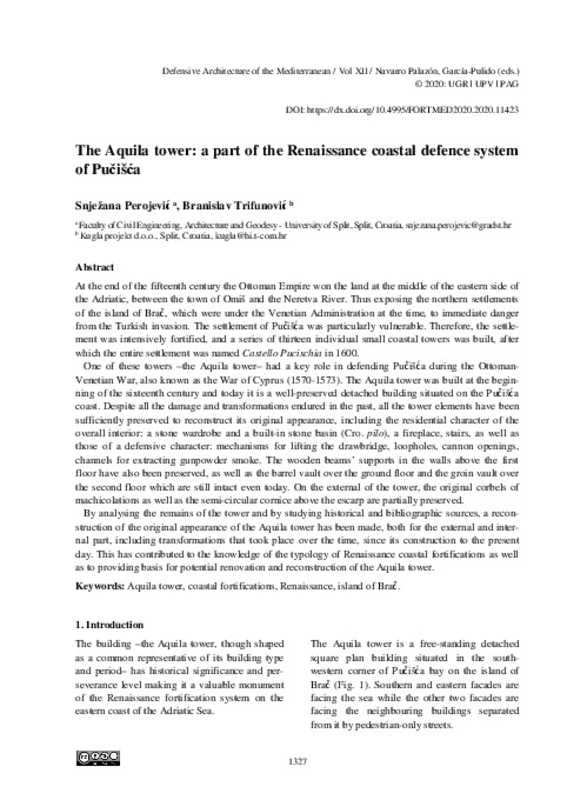JavaScript is disabled for your browser. Some features of this site may not work without it.
Buscar en RiuNet
Listar
Mi cuenta
Estadísticas
Ayuda RiuNet
Admin. UPV
The Aquila tower: a part of the Renaissance coastal defence system of Pučišća
Mostrar el registro sencillo del ítem
Ficheros en el ítem
| dc.contributor.author | Perojević, Snježana
|
es_ES |
| dc.contributor.author | Trifunović, Branislav
|
es_ES |
| dc.coverage.spatial | east=16.73370808961653; north=43.348787281403176; name=Novo Riva 3, 21412, Pučišća, Croàcia | es_ES |
| dc.date.accessioned | 2020-07-20T06:45:52Z | |
| dc.date.available | 2020-07-20T06:45:52Z | |
| dc.date.issued | 2020-05-15 | |
| dc.identifier.isbn | 9788490488560 | |
| dc.identifier.uri | http://hdl.handle.net/10251/148297 | |
| dc.description.abstract | [EN] At the end of the fifteenth century the Ottoman Empire won the land at the middle of the eastern side of the Adriatic, between the town of Omiš and the Neretva River. Thus exposing the northern settlements of the island of Brač, which were under the Venetian Administration at the time, to immediate danger from the Turkish invasion. The settlement of Pučišća was particularly vulnerable. Therefore, the settlement was intensively fortified, and a series of thirteen individual small coastal towers was built, after which the entire settlement was named Castello Pucischia in 1600. One of these towers –the Aquila tower– had a key role in defending Pučišća during the OttomanVenetian War, also known as the War of Cyprus (1570-1573). The Aquila tower was built at the beginning of the sixteenth century and today it is a well-preserved detached building situated on the Pučišća coast. Despite all the damage and transformations endured in the past, all the tower elements have been sufficiently preserved to reconstruct its original appearance, including the residential character of the overall interior: a stone wardrobe and a built-in stone basin (Cro. pilo), a fireplace, stairs, as well as those of a defensive character: mechanisms for lifting the drawbridge, loopholes, cannon openings, channels for extracting gunpowder smoke. The wooden beams’ supports in the walls above the first floor have also been preserved, as well as the barrel vault over the ground floor and the groin vault over the second floor which are still intact even today. On the external of the tower, the original corbels of machicolations as well as the semi-circular cornice above the escarp are partially preserved. By analysing the remains of the tower and by studying historical and bibliographic sources, a reconstruction of the original appearance of the Aquila tower has been made, both for the external and internal part, including transformations that took place over the time, since its construction to the present day. This has contributed to the knowledge of the typology of Renaissance coastal fortifications as well as to providing basis for potential renovation and reconstruction of the Aquila tower. | es_ES |
| dc.language | Inglés | es_ES |
| dc.publisher | Editorial Universitat Politècnica de València | es_ES |
| dc.rights | Reconocimiento - No comercial - Sin obra derivada (by-nc-nd) | es_ES |
| dc.subject | Fortifications | es_ES |
| dc.subject | Mediterranean | es_ES |
| dc.subject | Modern age | es_ES |
| dc.subject | Built Heritage | es_ES |
| dc.subject | Aquila tower | es_ES |
| dc.subject | Coastal fortifications | es_ES |
| dc.subject | Renaissance | es_ES |
| dc.subject | Island of Brač | es_ES |
| dc.title | The Aquila tower: a part of the Renaissance coastal defence system of Pučišća | es_ES |
| dc.type | Capítulo de libro | es_ES |
| dc.type | Comunicación en congreso | es_ES |
| dc.identifier.doi | 10.4995/FORTMED2020.2020.11423 | |
| dc.rights.accessRights | Abierto | es_ES |
| dc.description.bibliographicCitation | Perojević, S.; Trifunović, B. (2020). The Aquila tower: a part of the Renaissance coastal defence system of Pučišća. Editorial Universitat Politècnica de València. 1327-1334. https://doi.org/10.4995/FORTMED2020.2020.11423 | es_ES |
| dc.description.accrualMethod | OCS | es_ES |
| dc.relation.conferencename | FORTMED2020 - Defensive Architecture of the Mediterranean | es_ES |
| dc.relation.conferencedate | Octubre 01-03,2020 | es_ES |
| dc.relation.conferenceplace | Granada, Spain | es_ES |
| dc.relation.publisherversion | http://ocs.editorial.upv.es/index.php/FORTMED/FORTMED2020/paper/view/11423 | es_ES |
| dc.description.upvformatpinicio | 1327 | es_ES |
| dc.description.upvformatpfin | 1334 | es_ES |
| dc.type.version | info:eu-repo/semantics/publishedVersion | es_ES |
| dc.relation.pasarela | OCS\11423 | es_ES |








